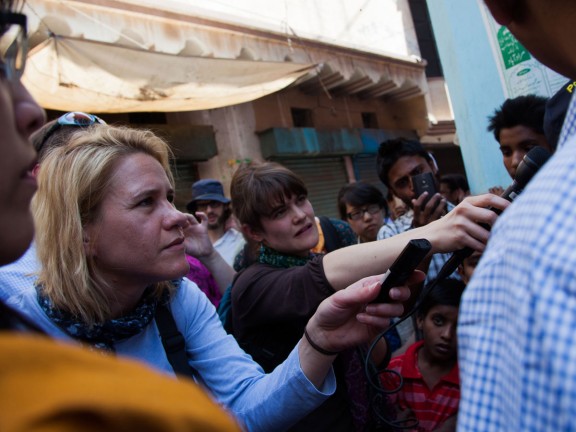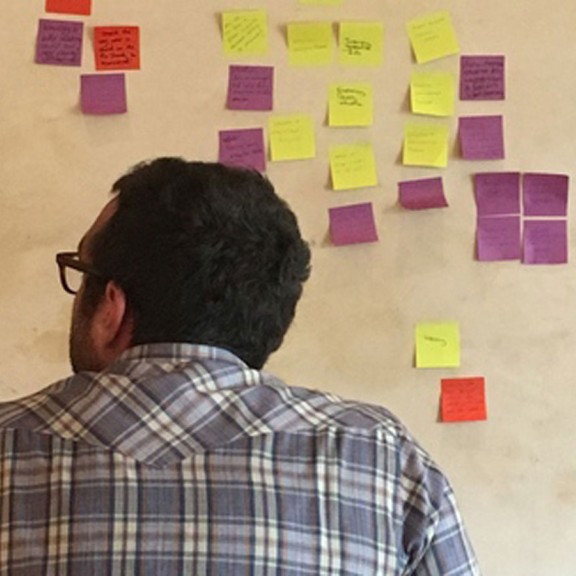Finding a Solutions-Oriented Story
Introduction
Many people who want to do solutions journalism aren't always sure where to begin. This is partly because, as illustrated above, it can be much easier to spot problems than solutions. It isn't that challenging to find examples of widespread problems. But it can take work to find places that are effectively responding to those problems.
Who Is Doing This Better?

That is the one question that can often help surface solutions better than any other. Imagine that you're chatting with an expert about mental health, and the conversation veers to your state's poor treatment of the mentally ill. This question may take the conversation in a new direction.
Of course, this doesn't mean that solutions don't exist. We just need to reorient how we see the world, to be more mindful of compelling solutions. Here are some suggestions on where to look:
Peer-reviewed academic papers
Randomized controlled trials (RCTs), case studies, and literature reviews can help surface what's working in different spheres. Google Scholar is a good place to start. Type in a few keywords (e.g., dental health Missouri immigrants) and consider narrowing the time period in which you look. Even reading over a few abstracts can give you a sense of the new thinking in a field.
Academic experts
If you have a chance, try contacting the authors of relevant academic papers — it's usually not too difficult to find contact information on institutional websites. Interview them, even if only for background purposes. Find out what groundbreaking events are helping define their fields, whether there are any cutting-edge research papers worth exploring, and if there are any rising academic stars worth following.
Large datasets
Datasets (for example, the Global Burden of Disease report) can help surface places and institutions that are having the most success at dealing with common problems. Is something happening in these locations that could be replicated elsewhere? This is known as the "positive deviance" approach to journalism.
People involved in implementation
One distinction between solutions journalism and traditional journalism is the emphasis on the "how." Good solutions-oriented stories report not only on what is happening, but also the nitty-gritty details of how it's done. For that reason, it's often beneficial to speak to people involved in direct implementation of an idea. For example, someone writing about innovations in daycare would find it vital to speak to daycare providers who have seen the implementation firsthand. Since subjects have an interest in claiming success, more than the usual skepticism is warranted.
Networks of innovators
Groups like Ashoka, The Aspen Institute, Echoing Green, The Skoll Foundation, The Schwab Foundation, and TED have vetted thousands of entrepreneurs and innovators. People in their networks could be great sources for solutions-oriented stories. Many of these networks hold social change conferences, which can be a great place to meet many of the people on this list.
Program officers in foundations
Foundations are in the business of vetting ideas. Many program officers have developed a deep understanding of their fields over time — and the ideas within them that have taken off. Since foundation officers will often over-sell their grantees, however, it can be more useful to ask them about programs they don't fund.
Your own expertise
If you have a beat, or you are drawn to a specific topic, build a network of contacts. They can tell you about innovative responses underway and introduce you to the people behind them.
Hold a mirror up to your own life
If you are having trouble vetting after-school options in your town, it's likely that others are struggling with it as well. Are there cities that have responded to this issue? Solutions journalism isn't just about responses to problems that "those" people face in faraway places, but all of us — including journalists. Some of the most successful solutions-oriented stories are grounded in personal experiences.
Reporting Instructively on Failure

In a way, the phrase "solutions journalism" is a bit of a misnomer. To many people who hear it for the first time, the word "solutions" implies that the journalist is claiming something to be the solution. (We hope that by this point, we have disabused you of that notion.)
In truth, we're interested in getting journalists to cover responses to problems, regardless of how well they are working. Journalists should be clear-eyed about what is working in these responses, and what is not working. The main goal of solutions stories is to yield practical insights for society about how a problem, or similar problems, could be more successfully addressed.
In this definition, it would be possible to bring a solutions lens to a seemingly failed response — as long as it makes society smarter in some way. Here are a few ways to consider doing just that:
Contrast the failure with a similar, more successful, alternative.
Ebola unfortunately spread quickly through much of West Africa in the summer of 2014. There were many important stories written about the plight of countries like Sierra Leone. But in August, the BBC's Catherine Byaruhanga reported on the East African nation of Uganda, which controlled Ebola through a health monitoring system. Her story played a unique role in informing the international community of potential for improvement.
Make sure the failure is instructive.
When interviewing people about a failed response, considering asking, Ã"What can others learn from this? What could have been done differently?" These questions can take your reporting beyond a typical story about a failed response.
Allow yourself to be open to shades of gray.
We would argue that only rarely could something be classified as a complete failure — or, conversely, a complete success. If you look at an issue with enough granularity, there will be shades of gray. As an example, Jeffery J. Silingo's piece in The New York Times examining what he called the "hype cycle" around MOOCs (massive open online courses), concluded that while they have failed to live up to inflated expectations of democratizing education, they "have become an important supplement to classroom learning and a tool for professional development."
Discuss why people are drawn to a failed idea.
This is particularly relevant if you plan to take down a straw man of an idea that has attracted many eyeballs and/or investor money. Take, for instance, TOMS shoes, one of the first and most popular "buy-one-give-one" businesses. Many consumers thought this model was a brilliant way to shop while making the world a better place. However, careful reporting shows that building up local shoe manufacturing would have more impact than donating foreign-made shoes. A full story about TOMS' flaws should include a discussion of why it was greeted with such enthusiasm. (In this case, well-intentioned consumers got smarter and TOMS actually changed their business model.)
Slices

Despite the emphasis on data journalism in the last few years, some journalists still shy away from large datasets. And when journalists do turn to data, it's often to investigate a negative outlier. Data usually informs journalistic inquiries like: What city has the worst crime rate? Where is governance the weakest? Where are racial and economic inequalities the greatest?
We suggest a different way for journalists to use data — exploring positive deviants, or slices of a dataset that get at the best performers. For example: Which hospital in Texas has the lowest infection rate? In which state is recidivism the lowest? What country has the highest participation of women in government?
A positive deviant is a signal that something newsworthy could be happening. It's the journalist's job to get the story behind the positive deviant — and in so doing, uncover information that could be valuable for people everywhere. Perhaps the Texas hospital found a way to encourage nurses to speak up when a doctor fails to wash hands. Maybe state prison authorities began providing mental- health services and drug treatment to recently released prisoners. Those are important stories. (That being said, a positive deviant could also signify nothing. It could be a quirk in the data, a function of demographics, or an inaccurate measurement. As we said, it's the journalist's job to find out!)
Positive deviant journalism works backwards from data outcomes. Some journalists hesitate to attempt solutions journalism because they fear being labeled advocates or PR representatives. But with positive deviant journalism, the data will guide you to a story — and therefore will refute any confusion with advocacy.
Next time you look at a dataset, here are a few ways to consider slicing it to find a noteworthy positive deviant. This table is not meant to be exhaustive, but rather to spur your imagination a bit.
| Strategy | Description | Education Story Examples | Violence Story Examples |
|---|---|---|---|
Change Over Time | Which place has made newsworthy improvement? | High poverty, high test scores: Auburn school is a shouting success The Seattle Times | Police 'de-escalation' training — how it could help Chicago Chicago Tribune |
Comparison to Peers | Which place is doing better than its comparable peers? | OPB FM | Santa Ana's 10-year war on prostitution Orange County Register |
Method/Best Practice | Which place is succeeding with innovative new ideas? | WAMU Breaking Ground | The simple idea that could transform US criminal justice The Guardian |
Coverage | Which place has greatly expanded access to a solution? | How One School District Used Buses to Bring the Internet Home Pacific Standard | Battling America's other PTSD crisis Yahoo! News |
Subgroup | Which place has improved outcomes for a particular population? | MPS looks to Oakland model to work differently with African-American Boys MinnPost | When Women Must Choose Between Abuse And Homelessness The Huffington Post |
Policy | Which government has instituted successful new policies to solve a problem? | Los Angeles policy shift yields decline in school suspensions Los Angeles Daily News | How Conservative, Tough-On-Crime Utah Reined In Police Militarization Buzzfeed |
Disparity | Which place has reduced racial, geographic or socioeconomic disparities in outcomes? | Northfield program shrinks Latino achievement gap MPR News | How the Gun Control Debate Ignores Black Lives ProPublica |
Cost | Which place has maintained good service while reducing costs? | How this private college maintains a $1 billion endowment without charging tuition Business Insider | Preventing Crime for Pennies on the Dollar Freakonomics |
Bringing a Solutions Lens to Short Pieces
You have one reporting day and 500 words. Or you have three hours to put together a 1-minute broadcast. How can you integrate a solutions mindset?
Gold standard solutions journalism is long and time-intensive. Many of the tips we offer elsewhere are best suited for longer-form feature or narrative pieces. We have found several ways, though, to bring a solutions focus into pieces where you do not have the luxury of space.
- Short solutions pieces work particularly well in cases where the problem is widely known. Consider bedbugs, which a few years ago were pervasive in New York City. A reporter for AM New York — a free newspaper distributed on the subway — spent one sentence on the problem, and was able to jump directly to the better news: that bedbugs were massively on the decline, thanks largely to the city's multi-pronged effort to eradicate them. In 576 words, the author tackled many of our "10 questions."
- Choose a subject that has data to prove it works. Then you needn't spend a lot of time or words making that case — you can get right to the how it works.
- Beat reporters may also do solutions stories quickly by covering local programs with good track records. Beat expertise allows you to save a lot of reporting time. We delve more into this on the following page.
- Some responses are less complex than others, making them a good fit for a short piece. For example, an Atlantic CityLab piece explored how Brazilians are increasingly hitting record on their cell phones when they witness police brutality. It's creating more accountability in the notoriously militaristic police force there.
Doing Solutions Journalism on Deadline
Doing solutions journalism as a regular beat reporter with weekly deadlines can seem daunting — but a solutions lens can actually help you frame and write shorter pieces quickly. Here are some methods to get Sojo into your regular, 800-word-or-less reporting.
The beauty of studies, especially when they are published and peer-reviewed, is that the vetting has been done for you by professionals. Researchers are usually very happy to get the word out about their findings and relatively easy to reach and interview, and they are bad at getting the word out to the public themselves. Interviewing other researchers in the same space, or who have published different findings, can round out the story. Reporting on reputable studies, like this one, can be a win for all parties—including the reading public who doesn’t regularly crack open issues of JAMA.
It doesn’t have to. A story built around the work of a couple nonprofits can be the basis of a solutions story as long as you tell the pros and cons, and talk not only to the providers of a service but to those purportedly benefitting as well. Do your research to be on the lookout for downsides to any solutions--keep in mind that solutions aren’t flawless. For example, this story reports on two nonprofit organizations working together in Virginia to help eight low-income households convert their homes to electric power. The project entailed replacing fossil-fuel based heating and cooling systems like stoves and water coolers with electric ones, and organizers estimate that over the course of 20 years the changes will result in the households avoiding the emission of over 2 million pounds of carbon dioxide. But the story also includes the problems and potential downsides of this approach—participants are experiencing confusion over the intricacies of the new equipment and the program lacks statewide legislative support. Simply including both sides puts the response in context and avoids overclaiming or reading like a puff piece.
Most really big problems don’t have any big, easy solution; that’s what makes big problems difficult. It’s easy to feel like you have to find a perfect or complete solution—but those rarely come along. Instead, free yourself to write about partial solutions by acknowledging that their reach is limited and that there is still work to be done and progress can be incremental. For example, take this story on “momobile” post-natal care that goes to moms so they don’t have to take time off work to travel to their doctor visits in Camden, New Jersey. Would it work the same everywhere, and does it solve the problem for all moms in the area? No. Is it helping a lot of people with a small but smart innovation? Yes.
It’s not your job to find “the” solution—embrace failures as part of finding best practices and solutions. For example, take this story on the school districts in Yonkers, New York, where the city made a big play to get their high school kids into college. The college access program was a major success—with over 85 percent of college seniors getting accepted to college—mostly at the local community college. The catch? A year later, they discovered that nearly all these same students had dropped out. Including the failure actually makes the story of college access more rigorous and complete. Why did the students drop out? What initiative needs to take place next to not just get kids into college, but help them complete a degree? This solutions reporting is more thorough because it includes the flaws and failures.
You will learn more about best practices and solutions as you develop your beat or area of emphasis. It’s okay to do shorter stories on pieces of a solution to a big problem—you could even think of it as a small series. For example, sex trafficking is a big problem with many approaches. This story explores law enforcement solutions to sex trafficking. The story that followed it explores intervention and housing solutions for sex trafficking. It’s okay to let the solutions evolve and take your readers along as you go—you don’t have to get it all right in one, be-all, end-all story.
Solutions Journalism and Investigations
In many ways, investigative reporting is an ideal vehicle for solutions journalism. The reporting mechanics are essentially the same in both cases: reporters must understand not just what happened, but how and why it happened.
If done well, solutions journalism can strengthen the most hard-hitting investigations. It’s a way to hold public officials responsible not just for bad stuff they may be doing, but also for the good stuff they aren’t trying. Profiling examples of success takes away any excuses for bad behavior. It’s also often a fresher, more reader-friendly way to report on a depressing subject.
Here are two ways you could add a solutions focus to your next investigative series:

Contrast your investigative expose with a solutions story
Strengthen your exposé by also reporting on a comparable or nearby place that’s doing it better. Many investigative series give a cursory mention to better responses. Don’t waste that story! Use it to explore deeply why that response works, and what others can learn from it.
The Center for Investigative Reporting’s Katharine Mieszkowski investigated the difficulty California parents face when looking for vital information about the safety of potential childcare providers. This was a critical first step in holding policy makers accountable. But like so many investigations, it was only the first step; pointing out the inadequacy of California’s outdated system spurred outrage, but didn’t provide answers as to what concerned parents might advocate for instead.
Courtney Martin later reported on Indiana, a state where inspectors are using the latest in technology—including tablets in the field—and administrators are structuring services online, in person, and over the phone so that busy, overwhelmed parents can get the information they need to keep their kids safe. Now California parents don’t just have the knowledge of what’s broken, but a viable example to point to when they demand better services.
Frame your investigation with a solutions story
Let’s say you are exposing bad behavior. For example, nursing home industry lobbyists persuade state legislatures to go soft on nursing home abuse. Or, the for-profit prison industry runs a public relations campaign that keeps states from instituting drug courts and other alternatives to prison.
Has any place successfully bucked that pressure to do the right thing? If so, you can tell the story of one place’s successful efforts to defy it. In the process, you can report on everything you would have put into a more traditionally- framed expose. In our section on solutions reporting and impact, we talk about how Tina Rosenberg did just this in her investigation of how Brazil handled the HIV/AIDS epidemic at the turn of the century.


Lane Anderson is a New York-based journalist and Senior Writing Lecturer at New York University. She has extensively covered issues of social justice and poverty, and has received numerous SPJ awards, as well as a health journalism fellowship from the USC Annenberg School for Journalism.